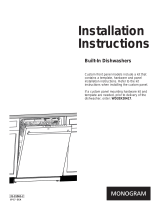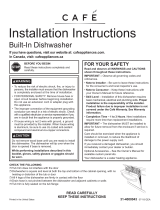
VEUILLEZ LIRE ATTENTIVEMENT
CONSERVER CES DIRECTIVES
ARRÊT
POUR VOTRE SÉCURITÉ
Veuillez lire et observer toutes les mises en garde
AVERTISSEMENT et ATTENTION données dans les
présentes directives.
IMPORTANT – Observez tous les codes et
ordonnances en vigueur.
• Note à l’installateur – Veuillez laisser les présentes
directives au consommateur pour l’inspecteur local.
• Note au consommateur – Veuillez conserver les
présentes directives avec votre Manuel d’utilisation
pour consultation ultérieure.
• Compétences requises – L’installation de ce
lave-vaisselle exige des compétences de base en
mécanique, en électricité et en plomberie.
L’installateur est responsable de la qualité
de l’installation. Toute défaillance du produit
attribuable à une installation inadéquate n’est
pas couverte par la Garantie de GE Appliances.
Reportez-vous à la Garantie du produit.
• Durée de l’installation – Entre 1 et 3 heures.
L’installation d’un nouveau lave-vaisselle exige plus de
temps que le remplacement d’un ancien modèle.
IMPORTANT – Le lave-vaisselle DOIT être installé de
manière à ce qu’il puisse être sorti de son emplacement
si des réparations sont nécessaires.
Il importe d'user de prudence lorsque l'appareil est
installé ou déplacé afin de prévenir l'endommagement
du cordon d'alimentation.
Si le lave-vaisselle que vous avez reçu est endommagé,
communiquez immédiatement avec votre détaillant ou
l’entrepreneur en construction.
Accessoires facultatifs – Reportez-vous au Manuel
d’utilisation pour connaître les ensembles pour panneau
décoratif personnalisé offerts.
Votre lave-vaisselle est un appareil qui chauffe l’eau.
• Pour réduire les risques de choc électrique, d’incendie ou de
blessures, l’installateur doit s’assurer que le lave-vaisselle
est complètement encastré au moment de l’installation.
• POUR VOTRE SÉCURITÉ PERSONNELLE: Enlevez
le fusible ou déclenchez le disjoncteur au panneau
de distribution principal avant de commencer
l’installation. N’utilisez pas une rallonge électrique ou
un adaptateur de fiche avec cet appareil.
• Un branchement inadéquat du conducteur de
mise à la terre peut présenter des risques de choc
électrique. Si vous n’êtes pas certain que l’appareil
est correctement mis à la terre, consultez un
réparateur ou un électricien qualifié.
• Si le câblage électrique de la résidence n’est pas
constitué de deux fils plus un fil de mise à la terre,
l’installateur doit installer un fil de mise à la terre. Si le
câblage électrique de la résidence est en aluminium,
utilisez un agent antioxydant et des connecteurs pour
raccords «aluminium-cuivre» homologués UL.
• Pour réduire les risques de choc électrique, d’incendie
ou de blessures, l’installateur doit vérifier pour s’assurer
que les fils ne sont pas pliés ou en dommagés, que
le câblage domestique est fixé au support de boîte
de connexion par l’entremise d’un serre-câble et que
toutes les connexions électriques faites au moment de
l’installation (capuchons de connexion) se trouvent
à l’intérieur du couvercle de la boîte de connexion.
N’enlevez pas la base de bois avant d’être prêt à installer
le lave-vaisselle. Si vous enlevez la base de bois, le lave-
vaisselle pourrait basculer lorsque vous ouvrez la porte.
Pour effectuer l’installation décrite dans les
présentes directives, il faut porter des gants et
des lunettes de sécurité.
AVERTISSEMENT
ATTENTION
AVANT DE COMMENCER
Veuillez lire attentivement toutes les directives qui
suivent.
CONTACTEZ NOUS
Pour le service local Monogram dans votre région:
1.800.444.1845.
Pièces et accessoires Monogram, appeler le:
1.800.626.2002.
Pièces et accessoires Monogram au Canada,
appeler le: 1.800.561.3344.
2
ACCESSOIRE DE PANNEAU FRONTAL
Les modèles avec panneau frontal sur commande
viennent avec une trousse comprenant un gabarit,
la quincaillerie et les instructions d’installation du
panneau. Se reporter aux instructions de la trousse
pour installer le panneau sur commande.
Commandez votre trousse de montage de panneau
et un gabarit personnalisés WD35X25996 avant
d’installer le lave-vaisselle, le cas échéant.





















